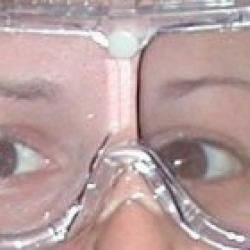Source Institutions
Source Institutions
Add to list Go to activity
Activity link broken? See if it's at the internet archive

In this activity, learners discover that the human brain is highly adaptable. Learners try to toss beanbags at a target while wearing prism goggles. Learners collect and interpret data and then have an opportunity to design additional experiments. This activity demonstrates how the brain adapts to new situations.
- 10 to 30 minutes
- 45 to 60 minutes
- $10 - $20 per group of students
- Ages 8 - 18
- Activity, Experiment/Lab Activity, Lesson/Lesson Plan
- English
Quick Guide
Materials List (per group of students)
- 1 pair of safety goggles
- Fresnel lenses/page magnifier (#406)
- 5-10 beanbags (same weight, shape, and texture)
- 1 target (a sheet of 8.5 x 11 paper works well)
- A wall with no distinguishing features that might help learners aim at the target
- Student Guide
- Individual or group data table(s)
Subjects
-
Life Sciences
-
Human Body
- The Brain and Nervous System
-
Human Senses and Perception
- Vision
- Perception
-
Human Body
-
Mathematics
-
Data Analysis and Probability
- Data Analysis
- Data Collection
- Data Representation
-
Data Analysis and Probability
-
Physical Sciences
-
Vibration and Waves
- Light and Optics
-
Light and Optics
- Lenses and Mirrors
- Reflection and Refraction
-
Vibration and Waves
-
The Nature of Science
-
The Scientific Process
- Asking Questions
- Conducting Investigations
- Gathering Data
- Formulating Explanations
- Communicating Results
-
The Scientific Process
Informal Categories
- Physical Activity
Audience
To use this activity, learners need to:
- see
- be mobile
- touch
Learning styles supported:
- Involves teamwork and communication skills
- Involves hands-on or lab activities
Other
Components that are part of this resource:
Includes alignment to state and/or national standards:
Includes assesments for student learning:
This resource is part of:
Access Rights:
- Free access
By:
Rights:
- All rights reserved, BrainU, 2011
Funding Sources:
- SEPA (Science Education Partnership Award) supported by the National Center for Research Resources, a part of the National Institutes of Health
- SEDAPA
- ARRA
